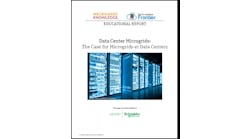Arizona and Ohio look like increasingly favorable turf for utility microgrids based on movement in the regulatory arena in recent weeks.
The Arizona Corporation Commission has given Arizona Public Service (APS) the okay to recover costs in rates for two microgrids. The approval was part of a larger rate case, the utility’s first in five years, which resulted in a 3.3 percent overall revenue increase.
APS developed a 25-MW military microgrid operating at an air station in Yuma, Arizona and a 63-MW data center microgrid in Phoenix for Aligned Data Centers. The utility took a risk in developing the projects without preapproval from the commission. Had the commission denied recovery, the utility shareholders would have paid the utility’s portion of the cost.
In an interview earlier this year, Scott Bordenkircher, APS director of T&D technology innovation and integration said that microgrids are the “right thing to do” for APS because they pencil under its business model – not just for the customer directly served by the microgrid, but also for the utility’s overall system.
APS said in a recent statement that the rate decision allows it to fund the continued development of innovative technologies such as battery storage, microgrids and advanced solar research.
“Arizona’s energy consumers are the clear winners here because this agreement enables investment in a smarter, cleaner energy infrastructure, gives customers more choice and control through new rate options, and continues Arizona’s solar leadership,” said Don Brandt, APS chairman, president and CEO.
AEP settlement allots $10.5 million for utility microgrids
Meanwhile, American Electric Power (AEP) Ohio has reached a rate settlement agreement, which among other things allows the utility to spend up to $10.5 million on one or more microgrid demonstration projects.
Filed for approval before the Public Utilities Commission of Ohio, the agreement would let AEP develop utility microgrids for non-profit or ‘public serving’ facilities. These include fire and police stations, municipal buildings, hospitals, social service agencies, emergency shelters, and water and sewer infrastructure facilities. Such entities will have an opportunity to apply to host, own and operate the microgrid. Lessons learned will be shared publicly.
The settlement also lets AEP Ohio pursue non-public serving microgrids. But in that case, the utility is limited in what costs it can recover – only those that are made on the distribution system and the utility’s side of the meter. The utility would select the non-public microgrid competitively. PUC staff would have the ability to reject the project if it deemed it not in the public interest.
AEP Ohio would not own the generation resources or batteries for the demonstration microgrids.
[clickToTweet tweet=”Utility #Microgrids Make Progress in Arizona and Ohio” quote=”Utility Microgrids Make Progress in Arizona and Ohio”]
The utility would recoup the costs for the microgrids by way of a smart grid rider, a special charge added to customer bills to recover the costs for the microgrids. The settlement also allows for an additional $10 million through the rider for electric vehicle charging demonstrations.
The settlement requires PUC approval to go forward. Several parties signed the agreement, among them the PUC staff, Constellation New Energy, the Retail Energy Supply Association, Natural Resources Defense Counci, Ohio Hospital Association, Ohio Manufacturers Association Energy Group, and other trade groups, businesses and environmental and consumer organizations.
Track news about utility microgrids by following Microgrid Knowledge on Twitter @MicrogridNews.






